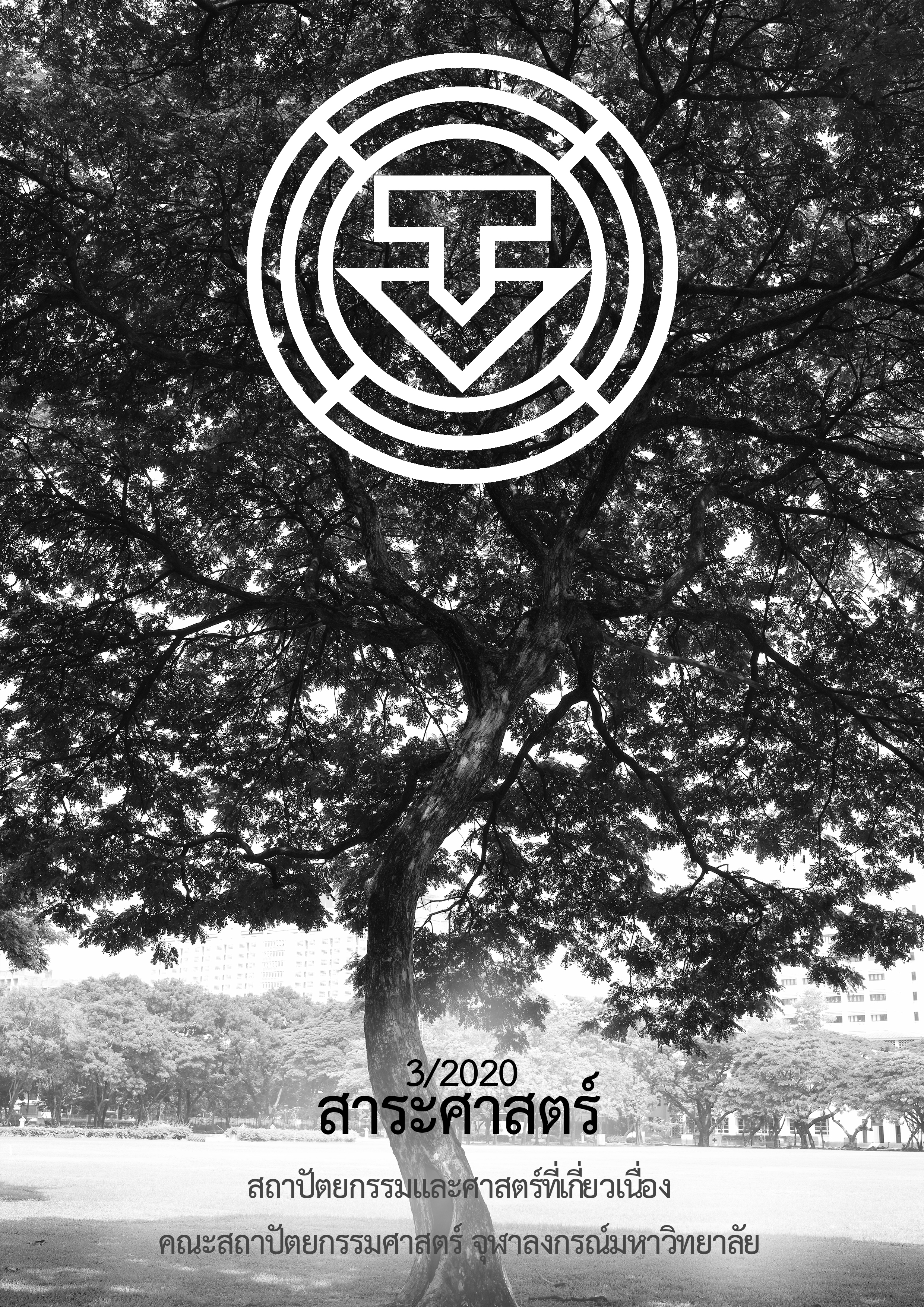Mental Well-Being of Dweller in Dwelling: Literature Review and Recommendation
Main Article Content
Abstract
Nowadays, well-being is one of the most interesting issues. Well-being consists of many parts; one of the parts is mental well-being or in another word is happiness which is one of mental health. Happiness, which is studied for a long time, is mostly considered by many sectors in various countries. An architecture industry also has studied the effects of the dwelling on the dweller’s mental health. Besides, the quality of dwelling is one of the important factors which can reach dweller’s health problems. Nowadays, many real estate firms are considered this significant issue through concepts, policy, vision, and products. Whereas, there is a consideration of the effect on dweller’s mental well-being from the dwelling’s design. Standards, which concern and attend to this topic, is not much.
In this article, the researcher researches the meaning of mental well-being and the correlation between well-being and happiness. Furthermore, the researcher not only gathers the building design standards which focusing on the dweller’s mental well-being and collects academic journals about the physical characteristics of the dwelling to accumulate and also analyses all variables from standards and academic journals. Many variables are categorized in many fields such as safety, aesthetics, orderliness, privacy, suitable environment, convenience, cleanness, suitable area size, noise pollution control, and accessibility of green areas. As a result, safety and suitable environment are the most considered categories. Secondary, are suitable area size and aesthetic that is concerned by all standards as safety.
However, the dwelling design standard for the mental well-being in Thailand is a lack of coverage. In the research study sector, the researches are only considered aboard. Mental well-being from the dwelling’s knowledge is rarely improved and has studied in small circles. Thus, the government and public organizations should support in academic studies for the improvement to develop design guidelines for mental well-being from the dwelling which meets the demand of dweller.
Article Details
References
การเคหะแห่งชาติ. ฝ่ายวิจัยและการก่อสร้าง. มาตรฐานที่อยู่อาศัยประเภทอาคารชุด. กรุงเทพฯ: การเคหะแห่งชาติ, 2525.
คเณศ นิพัทธ์ธีรนันท์. “รู้จักกับ WELL Building Standard เทรนด์มาตรฐานอาคารใหม่ที่เป็นห่วงสุขภาพของผู้อาศัยอย่างแท้จริง.” สืบค้น 29 กุมภาพันธ์ 2563. https://www.thestandard.co/anil-sathorn-12/.
ชุติมา พงศ์วรินทร์. “ความสุขของนิสิตนักศึกษาในบริบทพุทธธรรม: การศึกษาข้อมูลเชิงประจักษ์และการพัฒนามาตรวัด.” วิทยานิพนธ์ปริญญามหาบัณฑิต คณะจิตวิทยา จุฬาลงกรณ์มหาวิทยาลัย, 2555.
ดนัย บวรเกียรติกุล. การสุขาภิบาลที่อยู่อาศัยและสถานทำการ: เอกสารประกอบการสอน. ชลบุรี: คณะสาธารณสุขศาสตร์ มหาวิทยาลัยบูรพา, 2557. (เอกสารไม่ตีพิมพ์เผยแพร่).
บัวพันธ์ พรหมพักพิง. “ความอยู่ดีมีสุข: แนวคิดและประเด็นการศึกษาวิจัย.” วารสารมนุษยศาสตร์และสังคมศาสตร์ มหาวิทยาลัยขอนแก่น 23, 2 (มกราคม-มีนาคม 2549): 1-31.
บุญโรม สุวรรณพาหุ, อรัญญา ตุ้ยคัมภีร์ และวรรณี แกมเกตุ. “สุขภาวะของวัยรุ่น: กรอบมโนทัศน์และเครื่องมือประเมินทางจิตวิทยา.” วารสารพฤติกรรมศาสตร์ สถาบันวิจัยพฤติกรรมศาสตร์ มหาวิทยาลัยศรีนครินทรวิโรฒ 19, 2 (กรกฎาคม 2556): 131-134.
พระพรหมคุณาภรณ์. ความสุขที่สมบูรณ์. พิมพ์ครั้งที่ 26. กรุงเทพฯ: พิมพ์สวย, 2553.
พิศุทธิภา เมธีกุล. “ประสบการณ์การสูงวัยอย่างประสบความสำเร็จของผู้สูงอายุไทยที่มีสุขภาวะจิตสูง : การวิจัยเชิงคุณภาพ แบบทีมวิจัยเห็นชอบร่วมกัน.” วิทยานิพนธ์ปริญญามหาบัณฑิต คณะจิตวิทยา จุฬาลงกรณ์มหาวิทยาลัย, 2554.
ภาวดี ธุววงศ์. “การพัฒนาเกณฑ์การออกแบบอาคารเขียวเพื่อส่งเสริมสุขภาวะสำหรับอาคารที่อยู่อาศัยแบบยั่งยืนในประเทศไทย.” วิทยานิพนธ์ปริญญามหาบัณฑิต ภาควิชาเคหการ คณะสถาปัตยกรรมศาสตร์ จุฬาลงกรณ์มหาวิทยาลัย, 2559.
รศรินทร์ เกรย์, วรชัย ทองไทยและเรวดี สุวรรณนพเก้า. ความสุขเป็นสากล. พิมพ์ครั้งที่ 1. นครปฐม: จรัลสนิทวงศ์การพิมพ์, 2553.
อภิชัย มงคล, วัชนี หัตถพนม, ภัสรา เชษฐ์โชติศักดิ์, วรรณประภา ชะลอกุล, ละเอียด ปัญโญใหญ่และสุจริต สุวรรณชีพ. “ความสุขและสุขภาพจิตในบริบทสังคมไทย. วารสารสมาคมจิตแพทย์แห่งประเทศไทย 46,3 (กรกฎาคม-กันยายน 2544): 227-232.
อรพินทร์ ชูชม. “โครงสร้างของความสุขและสุขภาวะในจิตวิทยาเชิงบวก.” วารสารจิตวิทยา มหาวิทยาลัยเกษมบัณฑิต 6 (กรกฎาคม-ธันวาคม 2559): 1-7.
อัจศรา ประเสริฐสิน, ทัชชา สุริโยและปพน ณัฐเมธาวิน. “สุขภาวะของผู้สูงอายุ: แนวคิดและปัจจัยที่เกี่ยวข้อง.” วารสารสุขศึกษา 41, 1 (มกราคม-มิถุนายน 2561): 1-15.
Adam, T. B., J.R. Bezner, M.E. Drabbs, R.J. Zambarano and M.A. Steinhardt. “Conceptualization and Measurement of the Spiritual and Psychological Dimensions of Wellness in a College Population.” Journal of American College Health 48, 4 (January 2000): 165-173.
Centers for Disease Control and Prevention and U.S. Department of Housing and Urban Development. Healthy Housing Reference Manual. Atlanta: US Department of Health and Human Services, 2006.
Channon, B. “Designing Buildings to Improve Mental Health.” Accessed February 27, 2020. https://www.pbctoday.co.uk/news/building-control-news/buildings-improve-mental-health/51625/.
Clapham, D., C. Foye and J. Christian. “The Concept of Subjective Well-Being in Housing Research.” Housing, Theory and Society 35, 3 (August 2017): 261-280.
Evans, G. W., N. M. Wells and Moch, A. “Housing and Mental Health: A Review of the Evidence and a Methodological and Conceptual Critique.” Journal of Social 59, 3(2003): 475-500.
Fedkenheuer, M., and B. Wegener. “The Housing Well-Being Inventory: Understanding How People Interact with Their Homes.” Daylight & Architecture magazine by VELUX Group 23 (July 2015): 33-46.
Krieger, J., and D. L. Higgins. “Housing and Health: Time again for Public Health Action.” American Journal of Public Health 92, 5 (May 2002): 758-768.
Lai, L., and P. Rios. “Housing Design for Socialisation and Wellbeing.” Journal of Urban Design and Mental Health 3 (August 2017): 12.
McCumiskey, C. “The Wellbeing Wheel.” Accessed September 27, 2019. https://spiritualearth.com/wellbeing-wheel/.
Robertson, I. “What is Psychological Wellbeing?” Accessed September 27, 2019. https://www.robertsoncooper.com/blog/what-is-psychological-wellbeing/.
Smith, C. “The Impact of Obesity on the Psychological Wellbeing of the Adolescent Learner.” Accessed September 27, 2019. https://www.semanticscholar.org/paper/The-impact-of-obesity-on-the-psychological-well-of-Smith/85bdeb7f4daf0c8ee56ccdb9aeb0fd9b08fd714c#relatd-papers.
Streemers, K. “Architecture for Well-Being and Health.” Daylight & Architecture Magazine by VELUX Group 23 (July 2015): 9-12.
The International WELL Building Institute. “Multifamily Residential Checklist WELL v1.” Accessed February 27, 2020. https://resources.wellcertified.com/tools/multifamily-residential-checklist-well-v1/.
Veenhoven, R., and J., Ehrhardt. “The Cross-National Pattern of Happiness: Test of Predictions Implied in Three Theories of Happiness.” Social Indicators Research: An International and Interdisciplinary Journal for Quality-of-Life Measurement 34, 1 (January 1995): 33-68.
World Health Organization. Housing and Health Guidelines. Geneva: World Health Organization, 2018.


